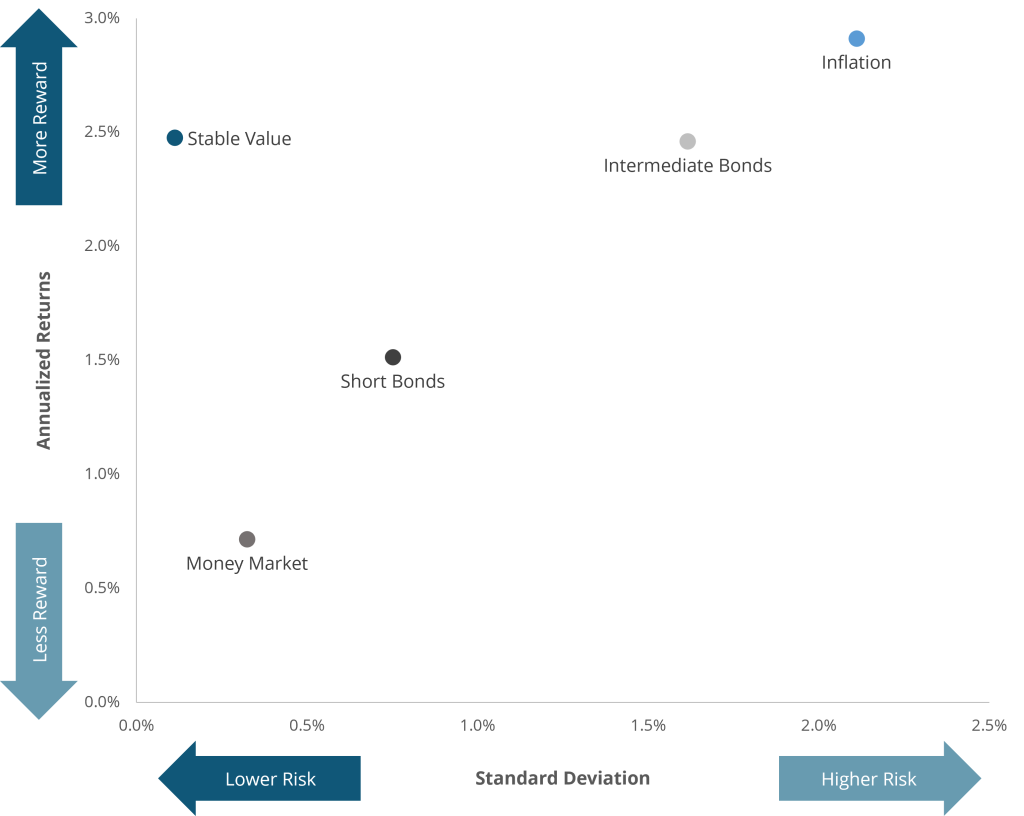Stable value is a core investment option in defined contribution plans. In fact, it has been a part of defined contribution plans for over 40 years. As of December 31, 2023, $882 billion was invested in stable value, which accounted for 10%1 of all defined contribution assets. Participants of all ages rely on stable value to help achieve their retirement goals.
Here are some reasons investors choose stable value:
1 – Attractive Long-Term Returns
Investors choose stable value because of the reliable long-term returns it provides for the portion of their savings that they don’t want to expose to significant risk. Stable value funds allow investors to earn returns similar to short or intermediate bond funds with lower volatility. This combination of low risk and attractive returns relative to other conservative investments has been demonstrated over the long term, as evidenced by the graph below. While the rapid rise in short term interest rates in 2022 and 2023 have temporarily made money market funds more attractive over the near-term, stable value crediting rates have been gradually rising – as designed – in response to higher market rates and averaged 3.01% as of December 2023.2

2 – Lower Risk
While no investment is risk-free, stable value is an attractive choice for a conservative investor as it is one of the lowest-risk options available in defined contribution plans. Besides investing in a highly rated and diversified portfolio of fixed income investments, stable value is also protected by investment contracts issued by insurance companies and banks that are designed to provide principal protection and shield investors from market volatility. Stable value is one of the few investments that did not lose money during either the financial crisis of 2008 or the COVID pandemic in 2020.
3 – Diversification
Stable value is an effective diversification vehicle. Since stable value returns have a low correlation (or relationship) to stocks, an allocation to stable value is a good complement to riskier investments in a retirement plan. In addition, stable value provides day-to-day principal protection that is not available from investments in bond funds. Utilizing stable value allows investors to build a more optimal portfolio and achieve a higher overall return with the same level of risk than could otherwise be accomplished without the use of stable value.
4 – Attractive for Retirement Income
Stable value is an attractive choice for investors in and near retirement as they shift from accumulating savings to thinking about how to generate retirement income and fund their retirement thanks to its attractive combination of low risk and return potential. Because it is designed to protect principal, stable value protects against sequence of returns risk, which is the risk of having to sell assets, such as equities or bonds, at depressed market values early in retirement which significantly reduces the longevity of the portfolio. Stable value also typically provides investors with daily liquidity, giving them the flexibility to draw upon their savings if faced with unexpected or unplanned expenses.
Helpful articles to highlight sequence of return risk can be found here:
Sequence of Returns Risk: Worse Than You Thought
Using Stable Value in Retirement to Protect Against Portfolio Depletion
5 – Time Tested
Stable value has been around since 1974, since the inception of defined contribution plans, and has been tested in numerous market cycles. As with most investments, stable value has evolved over time as the industry has innovated and responded to the changing needs of plan sponsors and participants. Over time, it has remained a trusted capital preservation option used by investors of all ages in 401(k), 457, 403(b), and 529 plans, among others, and it accounts for around 10% of the $10 trillion defined contribution plan assets as of December 31, 2023.
It is important to keep in mind that how you invest for your retirement depends on your life circumstances as well as your retirement date and your risk tolerance.
Stable value is only available in tax qualified plans and is not eligible to be held in individual retirement accounts (IRAs). Stable value should be considered as part of a well-balanced portfolio as an investment that can help investors manage risk and preserve principal while still earning a consistent, positive return. For help determining what an appropriate asset allocation would be, please speak with your retirement plan sponsor or financial advisor. For more information on stable value, check out these other helpful resources:
What is Stable Value?
Stable Value at a Glance
Stable Value Glossary
1 – ICI as of 3Q 2023
2 – SVIA Stable Value Quarterly Characteristics Survey for 4Q2023
3 – “Stable Value” is represented as a composite of the historical returns derived from data collected by the SVIA for its four stable value market segments (individually managed accounts, pooled funds, insurance company general accounts, and insurance company separate accounts). Data from 1989 to 2008 was collected from stable value managers to form a composite for use in research conducted by David Babbel and Miguel Herce, and data from 2008 to present is sourced from the SVIA’s Quarterly Characteristics Survey with the period from 2008 to 2015 derived from reported crediting rate data. Returns are gross of stable value management fees but net of fees necessary to deliver the product, such as stable value wrap, third party fixed income management, trust, custody, and fund administrative fees. This composite is composed of varying types of stable value products and, as such, should not be used as a comparison to a specific product.
“Money Market” is a simulation of money market returns from the iMoneyNet MFR Money Funds Index. Returns illustrated are gross before any fees.
”Intermediate Bonds” is a simulation of market value bond fund returns from the Barclays Intermediate Government/Credit Bond Index. Returns illustrated are gross before any fees.
“Short Bonds” is a simulation of market value bond fund returns from the Barclays Capital U.S. 1-3 Year Government/Credit Bond Index. Returns illustrated are gross before any fees.
“Inflation” is the monthly Consumer Price Index released by the US Bureau of Labor Statistics.
Disclaimer: The performance data shown represents past performance, which is not a guarantee of future results. Current performance may be lower or higher than the performance data cited. The performance of an index is not an exact representation of any particular investment, as you cannot invest directly in an index.

